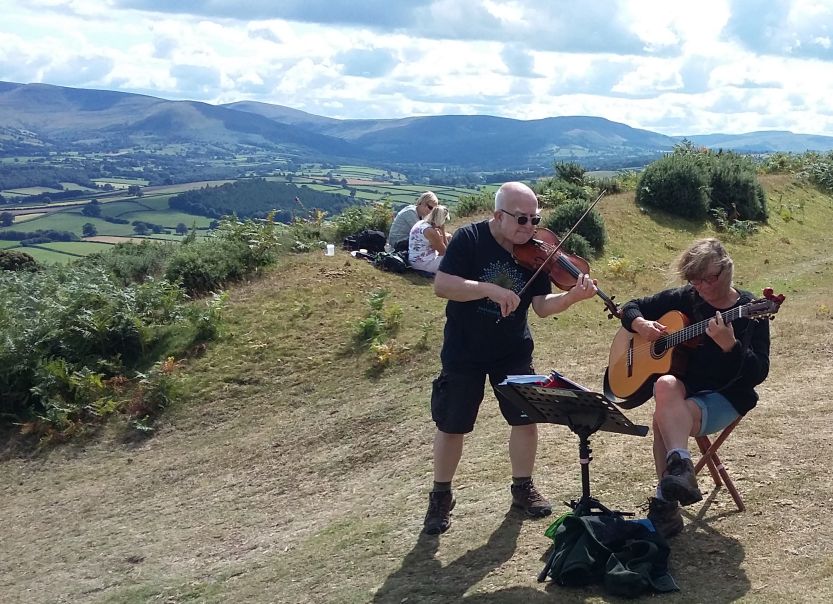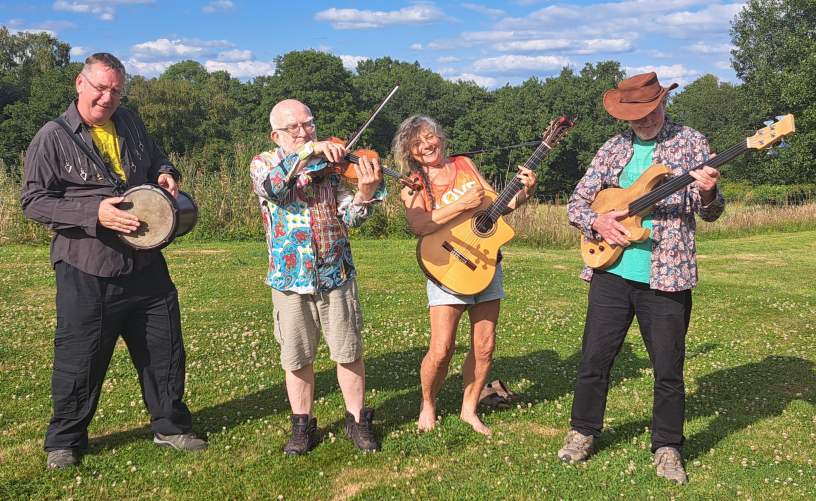Gypsy jazz plus

So... what is this "Gypsy jazz plus", as played by FiddleBop?
Heraclitus (a Greek philosopher who was around about 2500 years ago) reckoned that "There is nothing permanent except change". And he was right. Django Reinhardt and Stephane Grappelli jointly created that new thing, Gypsy jazz, in the 1930s, and since then the music has never stopped changing.

Changes in instrumentation, playing style, repertoire... the lot. Nowadays, there is a clear mainstream style of gypsy jazz. But the vigour of the music is such that there are also lots of thriving and unusual hybrids. Of which the present-day FiddleBop is one.
So how, exactly, is FiddleBop's music — we call it "Gypsy jazz plus" — different from mainstream Gypsy jazz?
For one thing, FiddleBop has a highly eclectic, even genre-agnostic, repertoire. Just like the early Gypsy jazz bands. We love playing music that isn't normally played by present-day mainstream Gypsy jazz bands (we also play selections from the standard Gypsy jazz repertoire, of course).
And for another thing, we have "different" instrumentation: amplified acoustic violin and Spanish guitar, plus fretless electric bass and percussion.
Anything else that distinguishes FiddleBop's "Gypsy jazz plus" from more mainstream present-day Gypsy jazz?
Three more things, we think.
- "The Charleston" and "Black Bottom" from the early days of jazz
- Swing-era stalwarts "Crazy Rhythm", "Dinah", "Puttin' on the Ritz", "Sweet Sue", and Duke Ellington's "It Don't Mean a Thing"
- Traditional Gypsy jazz tunes "Minor Swing", "Dark Eyes"; and Gypsy jazz staples "Bei Mir Bist du Shein", and "Sweet Georgia Brown"
- Our interpretations of the John Coltrane Quartet's exquisite "Naima" and "My Favourite Things"; bluesy versions of Thelonious Monk's "Round Midnight" and "Well, You Needn't"; classic cool jazz by Miles Davis, "Milestones" and "So What"; and FiddleBop's searing take of Dizzy Gillespie's "Night In Tunisia"
- Nostalgic close-harmony vocals on Paul McCartney's "Here, There, and Everywhere", Irving Berlin's "Cheek to Cheek" and "Blue Skies", and Jo's gospel-like "Still With Me"
- Jazz-favoured folk tunes such as "Give Me Your Hand" (c. 1603), Irish reel "Drowsy Maggie", and Ukrainian rouser "Odessa Bulgar"
- Jo's beautiful song for her Mum: "Still With Me", and her poetic late-night-smoky-bar "Thirteen-and-a-half Days In The Desert". And Dave's Gypsy-reggae "Party Politics".
"The blended voice is FiddleBop's choice." We love harmony singing. Now, vocals are common in modern Gypsy rumba bands like the Gypsy Kings, but they were not usual in Gypsy jazz bands of the 1930s. Vocal harmonies are still not that common in mainstream Gypsy jazz. But we in FiddleBop really enjoy blending our jazz voices!
"Hot jazz stomp, mais sans la pompe". Our approach to rhythm is a bit different from most Gypsy jazz bands. In the early years, Gypsy jazz was always played with a rhythmically rigid accompaniment called 'la pompe' ('the pump'). FiddleBop prefers a more fluid, flamenco-like style. Which Jo provides — in spades — and which underpins FiddleBop's powerful rhythmic drive, our exciting and sizzling version of hot Gypsy swing. Our FiddleBop beat for gypsy feet!
"Jazz of the best, but still with a jest." Creating music is what we love to do. But we try not to take ourselves too seriously. We in FiddleBop always have fun playing the music that we love. Which means that the audience has fun too!
And what is it that we share with all other Gypsy jazz groups, of whatever flavour?
That's easy: the sheer joy of creating music... and that indefinable but I-know-it-when-I-hear-it "Gypsy zing"!





 info@fiddlebop.org
info@fiddlebop.org 01982 560726
01982 560726 Site map
Site map @FiddleBop
@FiddleBop @fiddlebop
@fiddlebop @FiddleBop
@FiddleBop Get our email newsletter
Get our email newsletter

